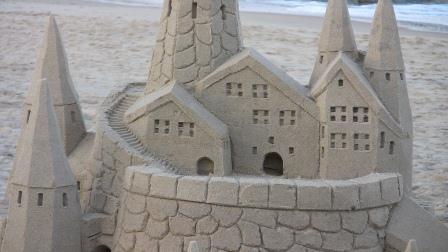We were peppered with sweat and sand as the sun set on another perfect summer’s day.
Proudly we stepped back to admire our work. A castle of sand patterned with moats, turrets, windows and a cavalcade of towers casting eerie shadows – it was a tribute to our collective handiwork.
It had taken hours.
We had ceaselessly toiled – digging, packing sand, building, smoothing and carefully carving out tunnels, passages and tiny, grainy chambers for both effect and our own simple satisfaction. The magnificence of the final result was overwhelming.
Its shadowy silhouette stretched across the sand, reaching toward the water.
Yes, W-A-T-E-R. It’s arch enemy. Oh.
The very thought of it was overwhelming in its destructiveness. Reality touched our thoughts. Had we built it far enough away from the creeping, twisting grasp of its fingers?
What if … ?
What if it reached our castle and wiped it out in one wave. Or worse, slowly eroded its foundations until it crumbled and collapsed, leaving little but gentle mounds rubbed smooth by the ebb and flow of the tide.
Nothing would be left; except our memories.
Too late it struck us that perhaps we should have built it elsewhere … somewhere safer.
Somewhere that was ours to protect.
Don’t build your castles on sand, or on another guy’s land
In our haste to stay on top of it all and keep control today, we’re often building castles of sand. And as there are so many ‘castle’ options, it’s easily done.
Unfortunately though, many of those castles can easily be washed away. And disappear.
As a close friend eloquently commented to me of late, “Social media is like reality TV. It’s exciting, entertaining and instantly satisfying. However, it doesn’t last – either in your memory or in real-time.”
If you take a look at the terms of service on social sites like Facebook, Twitter, LinkedIn and Google+ you may get a rude shock. You could realise that you’ve sweated on building an outpost that can disappear far quicker than it took to create.
Do you regularly place your contact list, address book, communications and customer records in the hands of another person, a business (who has their own agenda) or unthinkingly put them into their CRM? If you do, you shouldn’t be.
Easy to use and mould to our purpose, the social sites can be likened to the impermanence of sandcastles. They’ve lulled us into believing it’s easy, fun and a must-do, but for all their glorious positives, when you’re building on social sites you’re placing your castle on unsafe ground.
That land is theirs, not yours.
Different castles have different foundations
If everything you say and create is on social sites, it’s hard to have a permanent, valuable and ongoing presence – one that has future longevity and long-tail benefits.
In the same conversation my friend drew another analogy, “Blogs build long-term property value. They increase the overall worth of your site and best of all, they last – just like great TV series. How many million copies of the Seinfield series have been bought (and watched, endlessly) since it finished in 1998? That’s a decade and a half of long-tail benefits they’ve garnered from its intial creation.”
Your online home should be your most valuable asset, one that you maintain and enhance over time.
But … if you’ve built your ‘castles’ on another guy’s land (social sites) and shared all your content and insights there (rather than on your own site or blog) … where is your real home? Your home should be where your investment is anchored.
Your online home (AKA castle) should be somewhere you actually own and control – regardless of any changes to terms of service. It should hold the body of your work, safely.
Often people don’t realise that social media covers many things – social networking sites (Facebook, Twitter, LinkedIn), social bookmarking (Reddit, Digg, Delicious, StumbleUpon), media sharing services (YouTube) … and blogs.
Yes, blogs are a form of social media.
Fundamentally all social media is about sharing and connecting with friends, customers and contacts, and growing your community.
And to do all of that, a blog should be central to your plans.
Because you own it.
Blog castles contain riches
If you’re unfamiliar with blogs, to some it would seem that the other social sites replace the need for one. They all allow you to easily share, connect, converse, reconnect, interact and be social – as does a blog.
But there is a fundamental difference.
Blog content that is regularly updated, well thought out, insightful and helpful will provide ongoing, long-tail benefits and results for you. It will inform, engage, entertain or educate. Forever. That is valuable.
When in history have you ever heard of someone putting their riches (valuable content) on someone else’s land? Never, that’s when.
Instead, make sure you own the url that houses and protects your content. Then go out visiting your social groups as much as you want, post a link and drive the traffic back to your own land.
Better still, invite all your social groups back to your home to enjoy the wonders and riches you have, safely housed in your site/blog.
Make sure you’re building your castles on your own land – and not sand. Then you’ll be sure that the castle and its riches are there every time, forever.
And it hasn’t been washed away, by someone else.
Where are your castles?
Have you built your castles on the sand or on solid foundations that you own?
If they’re on the sand, you may find you can’t get into them one day. Where would you and your business be then?
How would your business be affected if you lost it all to the social sites?

